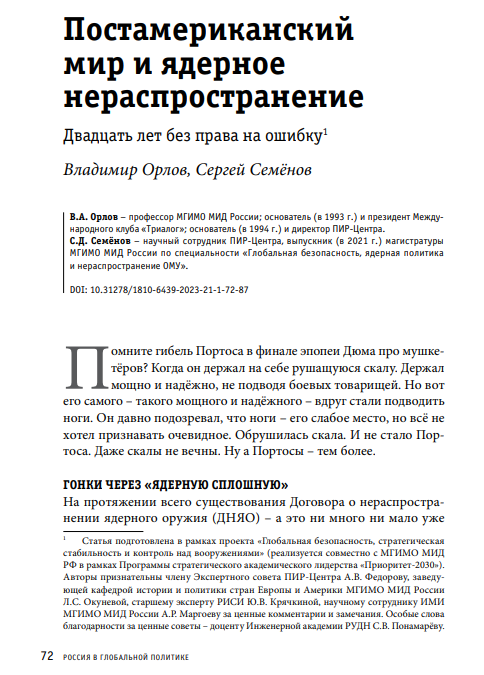MOSCOW. JANUARY 13. PIR PRESS. «Remember the death of Porthos at the end of Dumas’ epic about the Musketeers? When he held the crumbling cliff. He held powerfully and reliably without letting his comrades down. But here, he, so strong and dependable, began to fail his legs. He had long suspected that his legs were his weak point, but he still did not want to admit the obvious. The cliff collapsed and Porthos was gone. Even rocks are not eternal. Well, Porthoses – even more so» (from the introductory remarks to the article by V. Orlov and S. Semenov).
In January 2023, «Russia in Global Affairs» Journal published the article «The Post-American World and Nuclear Nonproliferation. 20 years with no room for error», written by MGIMO Professor, PIR Center Founder and Director Dr. Vladimir Orlov, and Research Fellow of Nuclear Nonproliferation and Russia Program Sergey Semenov.
The article analyzes scenarios for the development of the situation in the field of nuclear non-proliferation, which can lead to the emergence of new nuclear states on the political map.
It is emphasized that the balance of benefits and obligations laid down in the framework of the NPT regime still meets the interests of the absolute majority of world states. At the same time, the authors note that a number of states and territories (Japan, the Republic of Korea, Taiwan, Ukraine, Turkey, Egypt, Saudi Arabia, the Republic of Brazil, the Islamic Republic of Iran) may be interested in maintaining uncertainty about their nuclear ambitions and use this factor to strengthen their own geopolitical position.
The authors focus their attention on the fact that the policy of small nuclear steps is a symptom of the growing conflict in international affairs against the backdrop of the end of five hundred years of domination by the collective West, and under these conditions, attempts to «repair» the crumbling US-centric security architecture are doomed to failure.
At the same time, it is obvious that the formation of a new world order will take time, and the transition period will inevitably be accompanied by an increase in conflict and the diffusion of military-technical potentials. For this reason, it is in Russia’s interests to help build a new security architecture with a minimum number of dividing lines in regions where the risks of proliferation of weapons of mass destruction (WMD) are especially high.
The full text of the article can be found here: in Russian and in English.
To recall, in 2022 the PIR Center published a report «New Nuclear Nine? Assessing Nuclear Proliferation Threats in the World» which analyzes possible threats to the nuclear non-proliferation regime in the long term. The report notes that the current crisis of the nuclear non-proliferation regime is one of the clear markers of the erosion of existing security institutions. In this regard, the authors consider the Asia-Pacific region to be one of the likely «sore spots», where the intense rivalry between China and the United States provokes a new arms race and increases the risk of the emergence of new states, possessing nuclear weapons. As a result, the activities of the IAEA to verify nuclear activities become an important guarantee of maintaining the stability of the existing system of nuclear non-proliferation, provided that the Agency adheres to the principles of depoliticization and non-discrimination.
Read the Report (in Russian).
E3/TSU – 01/23
Key words: NPT
NPR/NPT


